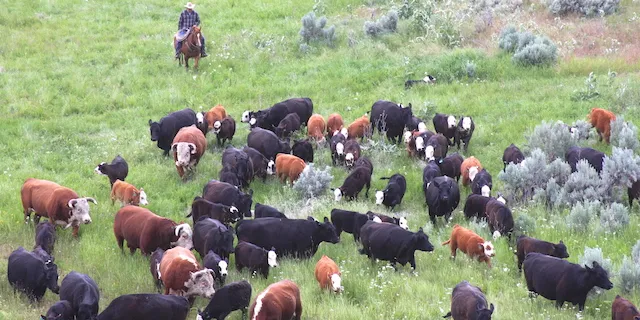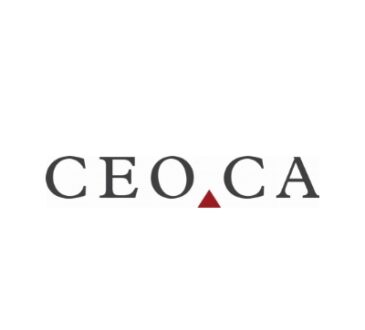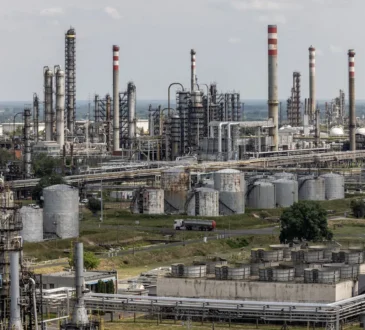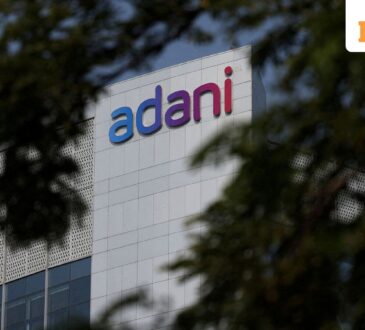
Ranchers feel bullish as cattle prices hit record highs this summer and remain elevated thanks to record low inventory and strong beef demand.
“It bodes well for us right now. If you’re a cow-calf producer, you’re in a good spot,” said Todd Nash, past president of the Oregon Cattlemen’s Association.
Experts don’t expect this beef cycle to end until 2028 at the earliest, as they believe cattle numbers will continue to shrink.
“When there’s a margin to be made, you have to take care of business. That might delay the rebuild,” said Cameron Mulrony, executive vice president of the Idaho Cattle Association.
Many producers feel compelled to sell rather than holding onto heifers that could contribute to national herd expansion.
Other ranchers are retaining calves because low feed costs result in efficient weight gains, but that strategy also tightens supplies.
“There are more guys right now that are playing the weight game,” said Chelsea Hajny, executive vice president of the Washington Cattlemen’s Association.
According to the USDA, feedlots prefer to hold cattle to heavier weights if supplies are tight to utilize pen space.
That results in a slow pace of marketing and heavier cattle.
Starting in July and through August, weekly cattle slaughter slowed seasonally but to levels that were the lowest since 2015.
While cow-calf producers and feedlots are cashing in, processors are feeling the pinch, according to an August Rabobank report.
“With cattle prices at new highs and wholesale beef values softening, weekly gross margins for steer and heifer processors are at their lowest level since April 2012,” the report stated.
According to that financial firm, per capita beef supplies have been stabilized by larger import volumes and elevated carcass weights.
Insiders said cattle produce far more meat per animal than in decades past thanks to improved genetics and management practices.
A retail price surge is being driven more by demand for beef, which is on track to be at its highest level since 1983, the report stated.
Hanging up their (cowboy) hats
Though prices hit records this summer, margins remain tight, said Bernt Nelson, an American Farm Bureau Federation economist.
Uncertainty lingers with tariffs, increased input costs and high interest rates for producers, many of whom are nearing retirement — their average age is 58.1.
Those factors also make it difficult for agricultural operations to expand or rebuild herds, Nelson said.
“It’s a good time to get out and a hard time to get in,” he added.
Younger ranchers likely will need off-farm employment, said Michael Alger, chairman of the OCA Young Cattlemen’s Committee.
“They’re going to have to get a job that pays well just to buy cattle,” added Alger, who ranches near Lincoln City and Willamina, Ore.
At the other end of the spectrum, Matt McElligott, Oregon Cattlemen’s Association president, said he knew several producers who sold all their heifers and planned to hang up their (cowboy) hats.
“A lot of people are saying, ‘This is going to be my last year,’ or, ‘I’ll ride this out until I’m done,’” McElligott added.
John Nalivka, the Idaho Cattle Association’s marketing chairman, said many older ranchers lack succession plans and face pressure to sell agricultural land to developers, further limiting inventories.
Small producers, who could contribute greatly to herd expansion, often have smaller parcels near communities and experience the most urgency to offload acreage, he added.
Debt and deferred maintenance also play into decisions.
“I think there’s a lot of guys, they’d gone into debt pretty significantly,” Nalivka said.
“This year is one of the few times in our industry that you could totally get out of debt,” he added.
Opportunity costs and risks
Many producers, even if they aim to keep running cattle for years, are unloading heifer calves.
Keeping a heifer calf this year presented an opportunity cost of $2,500 — the animal’s approximate sale value of that animal, Nalivka said.
But retaining a heifer calf also presents risk regarding the value she will generate as a bred heifer in a year, or with her own calf two years later.
Producers have to account for how much it costs to run the heifer during that time, said Nalivka, president of Sterling Marketing, a marketing advisory firm for restaurants, packers and feedlots.
There’s no guarantee high cattle prices will last or that a heifer will have a healthy calf, and the cost of grains probably won’t stay so low, he added.
Ranchers feel anxious about when the hot streak will end, since they know the market and Mother Nature are fickle.
“The last time we saw the end of the bubble, in 2014 or 2015, it dropped off so fast. People remember that,” said Nash.
Record cattle prices also impact the milk industry, with dairy farmers driven to produce beef-on-dairy calves that have partly propped up supply figures.
However, replacement heifers available to enter the dairy herd hit a 20-year low, according to an August CoBank report.
“The national dairy heifer shortage could persist and grow deeper in the next two years,” the report stated.
Initial causes of cattle shortage
Experts said several factors led to the U.S. beef cattle shortage, including weather-related problems such as persistent drought that reduced herds and blizzards on the Great Plains that killed thousands of cattle.
Ranchers also lost access to some public lands, making grazing more difficult.
Pandemic supply chain issues caused a beef backlog when feed costs were high and inputs kept increasing with inflation.
With low profitability, it became hard to keep a larger herd and some producers went out of business altogether.
Nelson, the Farm Bureau economist, said the industry contraction started before the pandemic but herd shortages, liquidation and consolidation were amplified by that event.
Record low inventory
On Jan. 1, the U.S. herd had shrunk to 86.7 million cattle and calves, the lowest figure since 1951, according to the USDA.
In July, the agency estimated the 2025 calf crop at 33.1 million, the smallest on record.
Nelson said there were mixed signals on whether heifer retention was occurring.
Since it takes two years before a cow can have a calf on its own, 2027 would be the first meaningful opportunity for herd expansion — but that’s only if ranchers keep heifers, he said.
“It’s more likely to occur in the spring of 2028,” Nelson added.
Some ranchers kept heifers for next year solely to alleviate taxes and avoid a higher income bracket, said Clint Sexson, marketing committee chairman for the Oregon Cattleman’s Association.
He added that the situation is unlike anything he’s seen in his life.
“If you’re operating on your own money, you own your property, you’re facing one of the biggest tax loads you’ve ever seen in the cow-calf world,” Sexson added.
Screwworm, imports and exports
Industry insiders anticipated slow growth for America’s cattle inventory once the market turns.
The situation is complicated by the threat of the New World screwworm and the closure of the border to livestock from Mexico.
That country supplies more than 1 million feeder cattle to U.S. feedlots every year.
Experts said keeping the screwworm out of the U.S. — the pest would cost billions of dollars — is far more important than Mexican cattle imports.
The ban on livestock means Mexico has more cattle to slaughter and beef imports from Mexico were up 14% year over year in July, according to the USDA.
Overall, U.S. beef imports are forecast to hit roughly 5.36 billion pounds in 2025, up 16% from the previous year, and then dip to 4.95 billion pounds in 2026.
Meanwhile, U.S. beef exports are projected at 2.6 billion pounds this year, down 12% from 2024. For 2026, beef exports are forecast at 2.52 billion pounds.
Strong consumer demand
Strong consumer demand continues, despite increasing retail costs.
Ranchers said higher quality and more consistent meat from better genetics and management has boosted demand.
The average U.S. ground beef price surpassed $6 per pound for the first time in June, hit a record $6.25 per pound in July, and climbed to $6.32 in August, according to the USDA.
“There’s only so much the consumer can take as far as high beef prices, but we don’t know what that tipping point is,” Nelson said.
A CattleFax report from July, prepared for the Beef Checkoff Program, indicated some consumers had started to trade down and show resistance to higher priced beef items.
Alger, who also runs a butcher shop in Willamina, Ore., said the industry must keep quality high so shoppers won’t back away from beef.
“They’re still buying for themselves and their family,” he said, adding butcher shops in western Oregon currently don’t have hook space.
Not a normal cycle
The beef cycle usually lasts about a decade, and this is year 12. Supply has contracted for seven years.
When cattle prices get high, there’s usually a corresponding increase in production.
“This isn’t your normal cycle,” Nelson said, noting record prices, high interest rates, geopolitical issues impacting trade, retiring ranchers and strong demand.
Barring some sort of catastrophic event, experts think the industry’s low supply and high prices will continue.




